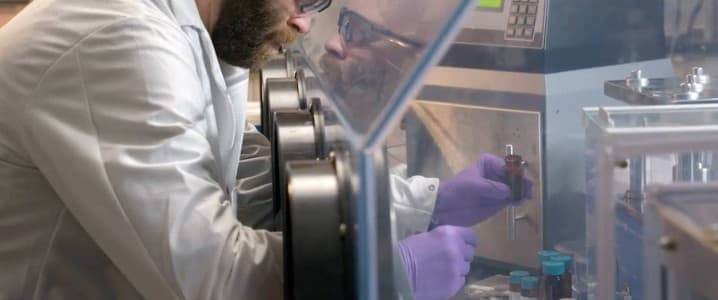The research paper has been published in the journal Sustainable Energy & Fuels. CoSn(OH)6 (CSO) is an effective oxygen evolution reaction (OER) catalyst, necessary for developing next-generation lithium-air batteries. However, current methods of synthesizing CSO are complicated and slow. Recently, an international research team synthesized CSO in a single step within 20 minutes using solution plasma to generate CSO nanocrystals with excellent OER catalytic properties. Their findings could boost the manufacturing of high energy density batteries.
There is pressure to reduce fossil fuel dependency and switch to alternative green energy sources. The development of electric vehicles is a move towards this direction.
However, electric vehicles require high energy density batteries for their functioning, and conventional lithium-ion batteries are not up to the task. Theoretically, lithium-air batteries provide a higher energy density than lithium-ion batteries. But before they can be put to practical use, these batteries need to be made energy efficient, their cycle characteristics need to be enhanced, and the overpotential needed to charge/discharge the oxygen redox reaction needs to be reduced.
To address these issues, a suitable catalyst is needed to accelerate the oxygen evolution reaction (OER) inside the battery. The OER is an extremely important chemical reaction involved in water splitting for improving the performance of storage batteries.
Rare and expensive noble metal oxides such as ruthenium(IV) oxide (RuO2) and iridium(IV) oxide (IrO2) have typically been used as catalysts to expedite the OER of metal-air batteries. More affordable catalytic materials include transition metals, such as perovskite-type oxides and hydroxides, which are known to be highly active for the OER.
CoSn(OH)6 (CSO) is one such perovskite-type hydroxide that is known to be a promising OER catalyst. However, current methods of synthesizing CSO are slow (require over 12 hours) and require multiple steps.
To address these issues, a suitable catalyst is needed to accelerate the oxygen evolution reaction (OER) inside the battery. The OER is an extremely important chemical reaction involved in water splitting for improving the performance of storage batteries. Rare and expensive noble metal oxides such as ruthenium(IV) oxide (RuO2) and iridium(IV) oxide (IrO2) have typically been used as catalysts to expedite the OER of metal-air batteries.
More affordable catalytic materials include transition metals, such as perovskite-type oxides and hydroxides, which are known to be highly active for the OER. CoSn(OH)6 (CSO) is one such perovskite-type hydroxide that is known to be a promising OER catalyst. However, current methods of synthesizing CSO are slow (require over 12 hours) and require multiple steps.
In a recent breakthrough, a research team from Shibaura Institute of Technology in Japan, led by Prof. Takahiro Ishizaki along with Mr. Masaki Narahara and Dr. Sangwoo Chae, managed to synthesize CSO in just 20 minutes using only a single step! To achieve this remarkable feat, the team used a solution plasma process, a cutting-edge method for material synthesis in a nonthermal reaction field. Their research was published in the journal Sustainable Energy & Fuels.
Related: Oil Prices Set For A Monthly Gain But Yet Another Quarterly Loss
The team used X-ray diffractometry to show that highly crystalline CSO could be synthesized from a precursor solution by adjusting the pH to values greater than 10 to 12. Using a transmission electron microscope, they further noticed that the CSO crystals were cube-shaped, with sizes of about 100-300 nm. The team also used X-ray photoelectron spectroscopy to investigate the composition and binding sites of CSO crystals and found Cobalt (Co) in a divalent and Tin (Sn) in a tetravalent state within the compound.
Finally, the team used an electrochemical method to look at the properties of CSO as a catalyst for OER. They observed that synthesized CSO had an overpotential of 350 mV at a current density of 10 mA cm−2.
“CSO synthesized at pH12 had the best catalytic property among all samples synthesized. In fact, this sample had slightly better catalytic properties than that of even commercial-grade RuO2,” highlighted Prof. Ishizaki. This was confirmed when the pH 12 sample was shown to have the lowest potential, specifically 104 mV lower than that of commercially available RuO2 vs. reversible hydrogen electrode at 10 mA cm−2.
Overall, this study describes, for the first time, an easy and efficient process for synthesizing CSO. This process makes CSO practically effective for use in lithium-air batteries and opens a new avenue towards the realization of next-generation electric batteries.
Prof. Ishizaki concluded, “The synthesized CSO showed superior electrocatalytic properties for OER. We hope that the perovskite-type CSO materials will be applied to energy devices and will contribute to the high functionalization of electric vehicles. This, in turn, will bring us one step closer towards achieving carbon neutrality by enabling a new energy system independent of fossil fuels.”
***
Lithium-air battery chemistry seems to offer quite a step up from the lithium-ion field. The theoretical number look really encouraging. One does hope that the technology will serve to extend the lithium supply.
But the small fly in the future is the long term performance. Lithium-ion came to market all set, same as perfect and remains to this day much less than the ideal originally proposed.
As this technology gets so close now to marketable it might be time to get on with some real long term testing to see just what the technology offers beyond more capacity.
By Brian Westenhaus via New Energy and Fuel
More Top Reads From Oilprice.com:
- Global Oil Reserves Could Increase Global Temperatures By 0.2°C
- Putin’s Plummeting Political Clout Is A Disaster For Xi
- How Russia’s Failed Coup Could Impact Global Commodities Markets


















